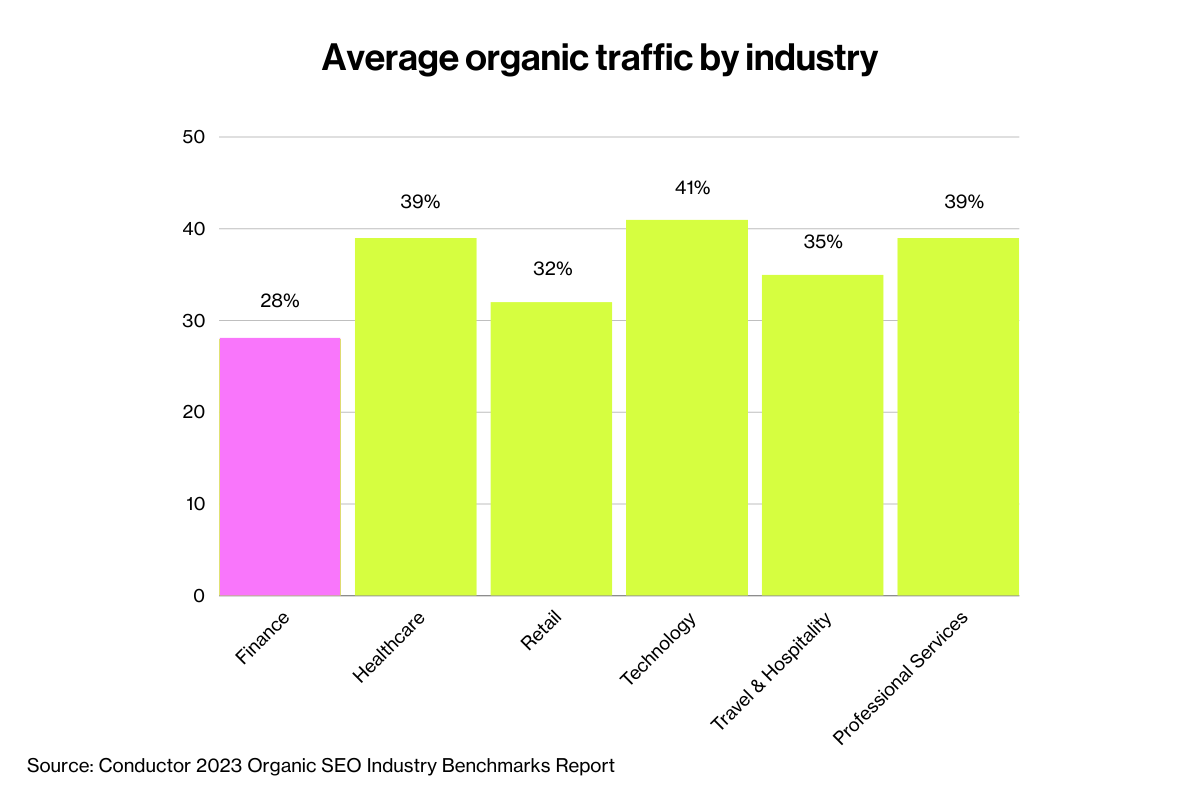
Creating Financial Services content that ranks
Getting financial services content to rank on page one of Google becomes more difficult every year. Aside from being in one of the most competitive industries, Google’s so-called “shrinking SERP” offers less organic visibility.
In an already competitive space, finance companies have to fight harder than ever to win and maintain visibility. We know this because, every year, we work with our finance clients to adjust their strategies, allowing them to gain ground on their competitors and move up the rankings.
So, let’s tackle the challenges head-on and discuss some of the most important strategies to get financial services content ranking higher in search.

Why is it so difficult for financial services content to rank?
Finance is widely regarded as one of the most difficult industries for SEO. According to Conductor's 2023 Organic SEO Industry Benchmarks Report, organic search accounts for 28% of all traffic for finance websites.

Across industries, organic search generates an average of 36% of all web traffic. Winning organic traffic from financial services content is one of the hardest things to do in SEO, but why is it so difficult?
Well, the reality is, that it is getting harder to rank financial content in search – for several reasons:
Competition: Finance is one of the most competitive niches in organic search with major players dominating the top spots for the most competitive keywords
Zero-click searches: You’re not only competing against business rivals but also search engines themselves with featured snippets, AI overviews and other search features providing instant answers to informational queries.
E-E-A-T and YMYL: Financial services content is some of the most scrutinised by Google’s quality raters.
Algorithm updates: You finally get your financial services content to rank and search engines move the goalposts with an algorithm update that tanks visibility.
Trust and scrutiny: Winning over search engines is one thing, but earning the trust of real people is another challenge entirely.
Stakeholder buy-in: Proving the value of SEO to stakeholders is a challenge in itself, especially at traditional finance institutions.
We face these challenges with every client in the finance industry. So let’s look at some of the most important strategies we’ve used to overcome these problems and help finance companies compete at the top of results pages.
Set high-impact SEO goals that align with business objectives
Given how difficult SEO is for finance companies and the intense competition you face, there’s little room for error. You need to get results quickly and prove the value of SEO to stakeholders.
Give them a taste of what SEO can do and, then, work with them to set long-term goals with reasonable budgets and timeframes.
Essentially, you’re splitting your strategy into two phases here:
Quick wins: Short-term goals you can achieve to gain quick traction and show the value of SEO.
Big wins: The more ambitious, long-term SEO goals offer bigger rewards but require more time and investment to achieve.
The key thing is to attribute every SEO outcome to the KPIs stakeholders care about revenue, profit, growth, etc. Yes, you want to create financial services content that ranks, but what value are these higher rankings adding to the business?
This was the biggest challenge we faced when BlackRock approached us wanting to increase global visibility and traffic.
We had to change the way the company thought about SEO by proving its value with quick wins. Then, we could use these results to show what we could achieve with more time and budget.
We built two work streams to deliver a short-term and long-term impact on SEO within the business. The first was focused on quick wins that had few internal dependencies to help us get buy-in for the bigger changes. The second focused on conversations with key stakeholders to showcase the business value of the larger technical recommendations and how they linked to wider company goals.
By aligning every campaign with the goals of the business and getting those quick wins, we got the buy-in we needed for bigger SEO goals.
Not only did we increase organic traffic by +256%, we attributed higher rankings and traffic volumes to conversions, revenue and business growth.
Find unique keyword and content opportunities
Sticking with the idea of quick wins followed by bigger SEO goals, let’s talk about keyword research. In a space as competitive as finance, finding new or low-competition keywords is crucial for gaining ground on your rivals.
Finding unique keyword and content opportunities is one of the best strategies for quick wins. However, beating rivals to new opportunities also gives you a long-term advantage. If you can optimise for the next big search trend before your competitors, that head start can be easier for you to keep than it is for them to reverse.
So, where can you find unique keywords and content ideas for finance?
Google Trends: Monitor relative search volumes for keywords, related keywords and topics to identify emerging trends.
Long-tail keywords: Find long-tail keywords that hit the sweet spot between search volumes, high intent and low competition.
People also ask: Scrape the “People also ask” box for relevant searches to find new content opportunities, topics, FAQs, etc.
Competitor analysis: Constantly analyse your competitors’ content to see which keywords they’re targeting, which topics they’re covering – and what they’re missing.
Forums: Analyse finance threads in the biggest forums like Reddit and Quora but also seek out finance-specific forums and any sub-niches relevant to you (eg: investment).
News: Finance is constantly changing, which means there’s always news, updates and new trends to cover (regulations, scandals, economic affairs, etc.).
Automate as much of this analysis as possible because it’s time-consuming otherwise. For example, you can export data from Google Trends to automatically monitor search interest.
Better yet, you can feed historical search data into a predictive analytics system to forecast increased search volumes and optimise for keyword opportunities before your competitors discover them.
Topic coverage is another important strategy that can help you find new or low-competition opportunities. Essentially, you start from your primary keywords and branch out into all of the valuable sub-topics.
You can explore topics with long-tail keywords, “People also ask” questions and the same analysis methods listed above. So, instead of putting all of your effort into the first search, you can target valuable follow-up searches to expand visibility.
You can even reverse-analyse search journeys to intercept opportunities.
Let’s say “small business loan” is one of your primary keywords. Next, you identify “small business loan low interest rate” as an important long-tail keyword, given the current environment. But what if you identify a search journey that doesn’t start with the keyword small business loan at all?
One that looks more like this:
“short term business loan”
“short term business loan pros and cons”
“are short term business loans risky”
“short term business loan interest rates”
“short term business loan alternatives”
“small business loan low interest rate”
If you can intercept that search journey with content covering the pros and cons of short-term loans, you can bring this audience over to your own content funnel.
Topic coverage can help you increase visibility for your target keywords but you can also use it to reach audiences who don’t even realise they’re in your market yet.
Satisfy the search intent with everything you publish
Search intent describes the purpose behind a user typing their specific query into a search engine. People turn to search engines because they need something. The more convincingly you satisfy their search intent, the more positive ranking signals you’re going to send to Google and other search engines.
Traditionally, SEO talks about three distinct types of search intent:
Navigational (branded searches): When a user includes a brand name in their query like “Direct Line” or “PayPal”.
Informational: When the query indicates the user is looking for information.
Commercial: When the query indicates the user is looking to buy something, either now or in the near future.
The problem is, that none of these categories explicitly describe what users are looking for when they turn to search or click through to a page.
Nobody’s comparing insurance policies and wondering whether their intent is informational or commercial. They’re looking for the best insurance policy that meets their specific needs.
Break beyond the idea of informational, navigational and commercial intents. What is the specific intent of your target audience for potential target keywords? What precise action are they trying to complete here?
Analyse Google AI Overviews and other SERP features (featured snippets, Knowledge Panels, etc.) to see how Google interprets user intent.
Align every target keyword with specific user actions. Are they simply comparing policies, are they actively looking for quotes or do they need a more competitive policy before their existing one expires?
Obviously, satisfying search intent pleases the user but it also sends the right signals back to Google.
Google’s algorithm is always getting better at analysing the relevance of content to search queries. However, engagement metrics still provide the best indication that a page satisfies the current search intent.
Quite simply, if your page is giving users what they want, they’re going to spend more time interacting with that page and the rest of your website.
Google is paying close attention to a variety of engagement metrics that describe how satisfied users are with the session:
Time on page/avg. engagement time
Avg. session duration
Pages visited (volume)
Bounce rate
Event count
Conversions
Specific events (CTA button clicks, video play button clicks, form submissions, etc.)
Above all, satisfying search intent is the most important thing here. That being said, user experience also plays a crucial role in sending the same positive signals – something we’ll come back to later.
Create content that relevant, high-authority sites will link to
With all of the progress Google has made over the past 25+ years, it hasn’t developed a more sophisticated method of overcoming its greatest challenge: content quality.
Google still relies heavily on its PageRank algorithm to determine the quality of page content for search results. Its fallback is a human team of quality raters who manually assess the quality of search results and page content.
Backlinks are the key signal in Google’s PageRank algorithm – so, yes, link building still matters in 2024.
More specifically, backlinks from high-authority websites relevant to the content you publish are the strongest signal you can send to the all-important PageRank algorithm.
Now, the more competitive your target keyword is, the more significant backlink quality becomes. We’ve spent a lot of time in this article talking about unique keyword opportunities and emerging trends for gaining ground on competitors.
Sooner or later, though, you have to fight for the most competitive keywords. Backlinks aren’t the only thing you need to optimise for, but they often make the difference when all your competitors are creating quality content, satisfying user intent, etc.
Quality beats quantity in this battle, so you want to build and maintain a profile of backlinks with the following characteristics:
Links from high-quality domains
Links from relevant domains
Descriptive anchor text
Placement in the main body of content
Links to the page you want to rank (not your homepage)
If you can regularly win backlinks that satisfy all of these criteria, you’re up there with the top-performing link profiles.
To do this, you need to create content that high-authority sites naturally link to in the main body of their content. As a finance company, you’ve got the advantage of being an authority on industry trends, economic issues, consumer interests and a variety of high-interest topics.
Take advantage of this by surveying customers or industry leaders and publishing your findings in reports. Build your own datasets and publish insights that target websites will want to use and reference (link to) in their own content.
Earning high-quality backlinks is difficult, but the payoff is worth the effort.
In 2016, Direct Line asked us to help with its rankings after suffering from a manual penalty back in 2013. By the time Direct Line approached us, they were ranking in 47th place for one of its most important keywords: “life insurance”.
As part of our recovery strategy, we reviewed and cleaned up the existing backlink profile for the life insurance page. Meanwhile, our content team got to work on publishing new, relevant content to win links from high-authority websites, securing 164 links in the process.
Within a year, Direct Line’s life insurance page was ranking in an all-time-high 4th position. This resulted in +975% organic traffic, +300% in sales from organic search and +249% ROI.
Optimise for E-E-A-T, YMYL and the helpful content update
Google needs people to keep using its search engine, so the last thing it wants to do is recommend dodgy loans or insurance providers. To protect users, Google employs a human team of search quality raters who assess search results and web pages, following its search quality rater guidelines.
These guidelines set out an assessment framework of experience, expertise, authoritativeness and trustworthiness (E-E-A-T).
Google specifies that trustworthiness is the most important factor in E-E-A-T with experience, expertise and authoritativeness all contributing to the overall trustworthiness of a page/website.
As a financial company, the actions people take on your website and the information you provide them can significantly impact their lives.
As a result, Google classifies financial websites and content as YMYL (Your Money or Your Life) and instructs quality raters to apply the strictest E-E-A-T standards.
This means your content needs to meet the very highest standards of E-E-A-T:
Quality: Publish the highest quality of content for each topic.
Accuracy: Make sure everything you publish is 100% factually accurate and backed up with the latest data where possible.
Credible sources: Only use credible sources for stats and other references – and update them as information ages.
Relevance: Make sure content is relevant to the target keyword and the search intent of the user.
User intent: Quality raters are specifically asked to assess how well pages satisfy user intent – another reason to prioritise this for financial services content.
Freshness: Keep your content up-to-date to maintain quality, accuracy and the recency of important information.
Backlinks: If authoritative sites trust your content enough to link back to it, that says a lot about your E-E-A-T.
Author bios: Show your expertise by including author bios on everything you publish, including their credentials.
Building on E-E-A-T, Google rolled out the helpful content update in August 2022. Google incorporated the helpful content signals into its core algorithm this year, as part of the March 2024 core update.
The core component of the helpful content update is creating content for people. This brings us back to the idea of knowing the search intent for every target query and satisfying this with your content.
Every page you publish should help users achieve something and guide them towards the next step of their journey. Use this premise to create “content funnels” that address your audience’s needs as they progress through the customer journey.
Update, consolidate and improve your existing content
Even the best content ages and its quality degrades over time. Information becomes outdated, your competitors are trying to outperform you and even your own content can start to compete against you.
This means your content is going to slide down the rankings unless you take action.
The good news is, that you can maintain – and even improve – the ranking of your existing content with a three-step strategy:
Content updates: Update your existing content to improve its quality, maintain accuracy and update any stats or other supporting references.
Content consolidation: Merge any pages targeting the same keyword into a single, superior piece of content.
Content removal: Remove pages that fail to gain any traction, are no longer relevant or simply aren’t worth updating.
During our 2019 public liability insurance campaign for Direct Line, keyword cannibalisation was one of the first technical SEO issues we addressed.
Keyword cannibalisation happens when you have multiple pages competing for the same keyword. This splits your ranking potential between multiple pages, instead of having one page that ranks higher for the target keyword.
For Direct Line, this meant its core product pages weren’t ranking as high as they could have.
By resolving cannibalisation issues, we quickly maximised the ranking potential of Direct Line's most important pages. Then, we optimised each page to push them further up the SERPs, using schema markup, internal links and a range of other strategies.
Over a 12-month period, our campaign resulted in +50% organic traffic, +399% policy quotations and +491% policy sales.
Bringing it all together
By bringing all of the strategies we’ve covered in this article together, you can get your content – new and old – to rank higher in search:
Set high-impact SEO goals that align with business objectives
Find unique keyword and content opportunities
Satisfy the search intent with everything you publish
Create content that relevant, high-authority sites will link to
Optimise for E-E-A-T, YMYL and the helpful content update
Update, consolidate and improve your existing content
Every step of the way, attribute higher rankings to the goals of the business. Prove the value of your SEO and content strategies by showing the direct impact on revenue, growth and ROI.
Reddico financial services clients
Reddico has worked with numerous leading financial services brands including BlackRock (case study), Compare the Market, Direct Line (case study), eFront, Totally Money and Wellington Management. If you'd like to discuss how we can help your business create content that ranks contact us >
Sign-up to Reddico News
To keep up-to-date with the latest developments in the world of SEO, our insights, industry case studies and company news, sign-up here.




